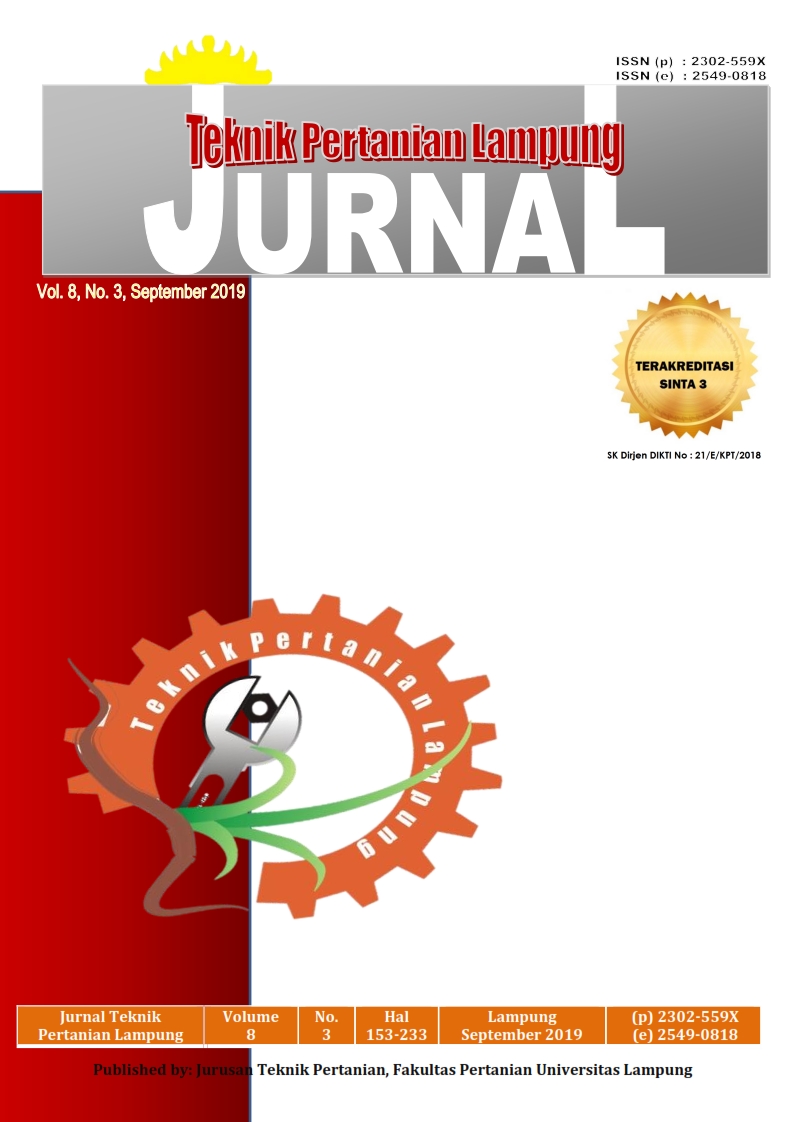POTENSI BIOGAS DARI PROSES REKAYASA AKLIMATISASI BIOREAKTOR AKIBAT PERUBAHAN SUBSTRAT PADA INDUSTRI BIOETHANOL
DOI:
https://doi.org/10.23960/jtep-l.v8i3.224-233Abstract
Produksi etanol (bioetanol) dari bahan baku biomassa merupakan salah satu cara mengurangi polusi lingkungan dan konsumsi terhadap minyak mentah. Salah satu bahan bakar yang dapat diperbaharui yakni bioethanol yang merupakan produk turunan dari singkong dan tetes tebu dengan menggunakan teknik proses multiple feedstock system. Industri bioethanol tidak hanya memproduksi produk utama berupa etanol, tetapi juga menghasilkan air limbah dalam jumlah besar. Air limbah bioethanol berbahan baku singkong disebut dengan thinslop, sedangkan air limbah bioethanol berbahan baku tetes tebu disebut dengan vinasse. Adanya proses perubahan substrat dari thinslop ke vinasse akan menyebabkan perubahan beban mikroorganisme dalam penguraian bahan organik . Tujuan dari penelitian yakni untuk mengukur potensi produksi biogas dari proses rekayasa aklimatisasi perubahan substrat. Penelitian menggunakan tiga bioreaktor CSTR dengan kapasitas 50 L. Perlakuan setiap bioreaktor yakni 50% thinslop dan 50% vinasse; 25% thinslop dan 75% Vinasse, dan 100% Vinasse, dengan laju pembebanan berbeda setiap minggu (0,5 g / L hari, 1,0 g / L hari, 1,5 g / L hari, dan 2,0 g / L hari). Hasil penelitian menunjukkan bahwa nilai potensial biogas dari bioreaktor pertama (50% thinslop: 50% vinasse), bioreaktor kedua (25% thinslop: 75% vinasse), dan bioreaktor ketiga (100% vinasse) berturut-turut yakni 39,39 L/hari, 38,97 L/hari 27,23 L/hari. Hasil penelitian juga menunjukkan bahwa kandungan gas metana secara berturut-turut dari bioreaktor pertama, bioreaktor kedua, dan bioreaktor ketiga (100% vinasse) sekitar 32,67-52,81%, 40,29-67,29%, 20,46-57,33%.
Kata kunci : bioethanol, singkong, tetes tebu, bireaktor, aklimatisasi
References
Ali, S. 2002. Move towards a Zero Liquid Discharge Distillery. 2nd FICCI-TERI Global Conference, New Delhi.
Hasanudin, U., Suroso, E., Risfaheri, dam Misgiyarta. 2007. Optimasi Fermentasi Air Limbah Tapioka Sebagai Sumber Biogas. Laporan Hasil Penelitian. Universitas Lampung.
Ibeto, C. N., Ofuefule, A. U and Agbo, K. E.. 2011. A Global Overview of Biomass Potentials for Bioethanol Production: A Renewable Alternative Fuel. Trends in Applied Sciences Research 6, (5): 410-425.
Kraigher, B., Kosjek, T., Heath, E., Kompare, B., Mandic-Mulec, I., Influence of pharmaceutical residues on the structure of activated sludge bacterial communities in wastewater treatment bioreactors.Water Research, 42, 4578-4588 (2008).
Kuiper, L., Burcu, E., Carlo, H., Willem, H., Sebastian, M. And Klass, K. 2007. Bioethanol from Cassava. Journal or Ecofys Netherlands BV. 38 Halaman.
Maryanti. 2011. Peningkatan Kinerja Reaktor Biogas Dalam pemngolahan Air Limbah Industri Bioetanol Berbahan Baku Singkong. (Thesis) . Universitas Lampung. Lampung. 114 Halaman.
Medco Energi Chemicals. 2007. Process Overview Multi Feedstock Ethanol Plant190 KLPD. 29 Halaman.
Shimadzu Corporation. 2004. GC – 2014 Gas Chromathography Instruction Manual. Shimadzu Corporation Analitical and Measuring Instrument Division. Kyoto. Japan.
Shinagawa Corporation. 2006. Gas Production Instrustion Manual. Sinagawa Corporation. Japan.
Siregar, S.A. 2010. Bioreaktor Anaerobik Tangki Berpengaduk dengan Kapasitas Sebesar 50 L. http://wastewater-indonesia-blogspot.com/2011/04/iogas-021-kg-ch4-kg-cod-removal.html.
Downloads
Published
Issue
Section
License
- Authors who publish with this journal agree to the following terms:
- Authors retain copyright and grant the journal right of first publication with the work simultaneously licensed under a Creative Commons Attribution-ShareAlike 4.0 International Lice that allows others to share the work with an acknowledgement of the work's authorship and initial publication in this journal.
- Authors are able to enter into separate, additional contractual arrangements for the non-exclusive distribution of the journal's published version of the work (e.g., post it to an institutional repository or publish it in a book), with an acknowledgement of its initial publication in this journal.
- Authors are permitted and encouraged to post their work online (e.g., in institutional repositories or on their website) prior to and during the submission process, as it can lead to productive exchanges, as well as earlier and greater citation of published work (See The Effect of Open Access).
Jurnal Teknik Pertanian Lampung

JTEPL is licensed under a Creative Commons Attribution-ShareAlike 4.0 International License.

